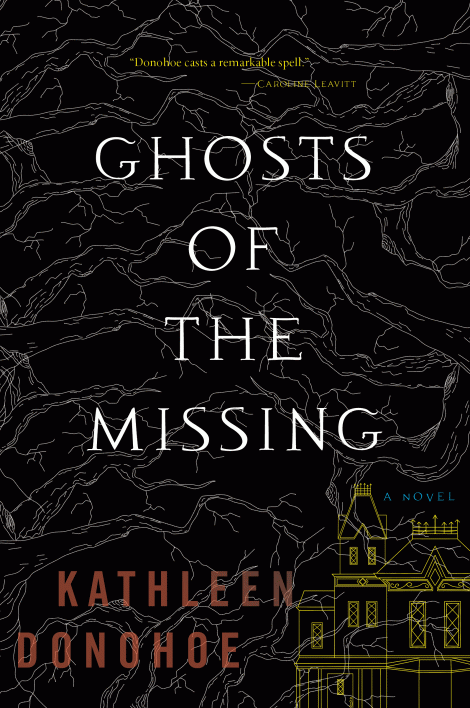
GHOSTS OF THE MISSING
In the vein of The Lovely Bones and The Little Friend, Ghosts of the Missing follows the mysterious disappearance of a twelve-year-old girl during a town parade and the reverberations of this tragedy throughout the town.
On Saturday, October 28, 1995, a girl vanished. She was not a child particularly prized in town…When questioned by reporters, those who’d known Rowan described her as ‘quiet’ and ‘loner’ and ‘shy’ and even ‘awkward.’ Words for pity.
Culleton, New York has a long history—of writers, of artists, and of unsolved mysteries.
In the vein of The Lovely Bones and The Little Friend, Ghosts of the Missing follows the mysterious disappearance of a twelve-year-old girl during a town parade and the reverberations of this tragedy throughout the town.
On Saturday, October 28, 1995, a girl vanished. She was not a child particularly prized in town…When questioned by reporters, those who’d known Rowan described her as ‘quiet’ and ‘loner’ and ‘shy’ and even ‘awkward.’ Words for pity.
Culleton, New York has a long history—of writers, of artists, and of unsolved mysteries. It’s where Adair grew up before she moved to Brooklyn to try to make it as an artist. But after years away from her hometown and little to show for it, Adair decides to return. She moves back in to Moye House, the old mansion, and current writer’s retreat, imbued with her family’s legacy.
Ciaran is a writer staying at Moye House in the hopes of finally solving the mystery of what happened to Rowan Kinnane—his sister, and Adair’s childhood best friend. As the two begin investigating, secrets long buried rise to the surface, complicating their sense of themselves and their understanding of what happened on that fateful day.
With her “knack for capturing heartbreaking moments with a gripping simplicity” (Village Voice), Kathleen Donohoe lures us into a haunting world of secrets and obsessions and shows just how far people will go in search of the truth.
- Houghton Mifflin Harcourt
- Paperback
- February 2020
- 320 Pages
- 9780544557178
About Kathleen Donohoe
 Kathleen Donohoe is the author of Ashes of Fiery Weather. Her stories and essays have appeared in The Recorder, New York Stories, and Washington Square Review. She serves on the Board of Irish American Writers & Artists. She lives in Brooklyn with her husband and son.
Kathleen Donohoe is the author of Ashes of Fiery Weather. Her stories and essays have appeared in The Recorder, New York Stories, and Washington Square Review. She serves on the Board of Irish American Writers & Artists. She lives in Brooklyn with her husband and son.
Praise
“Donohoe is skilled at cultivating the pervasively disconcerting and melancholy atmosphere that surrounds both Culleton and Adair. There is an impressive weaving of science and mysticism so that when the reader realizes the ‘fact’ behind a family’s curse, it stays just as foreboding as it was when it was just fantastical…A meditation on loss and the power of memory and tradition. A reflective tale of a town’s and a girl’s histories through the lens of rumor, storytelling, and ghosts.” —Kirkus Reviews
“[An] evocative mystery…Donohoe’s narrative travels liberally between present and past, anchored by her strong Irish-American women. This well-crafted novel will also appeal to literary fiction fans.” —Publishers Weekly
“A missing 12-year-old. A sleepy small town. A return home after a move to the big city. These familiar threads take on an otherworldly quality in Kathleen Donohoe’s mystery…Donohoe’s richly poetic style—which reminded us at times of The Lovely Bones—and her complex and relatable characters make Ghosts of the Missing a powerful, eerie read.” —Apple Books Review
“Smart, atmospheric…Donohoe unspools her story in a calm, hypnotic style…There is a fairytale air to much of this book and a level of enchantment throughout…An intelligent, evocative tale of grief and loss.” —Washington Independent Review of Books
“Donohoe offers a thoughtful exploration of loss and of how the past reverberates in the present.” —Booklist
“Smart, gorgeously written, and fabulously unsettling, Donohoe’s novel is about a twelve-year-old girl who vanishes during a parade, and how years later, her tormented best friend struggles to find out what really happened to her and why. About the enduring bonds of friendship, the garrote of secrets, and the most important story of all: how we live and how we die. Donohoe casts a remarkable spell. Loved, loved, loved this novel.” —Caroline Leavitt, New York Times bestselling author of Pictures of You and Cruel Beautiful World
“Kathleen Donohoe is a writer of insight, understanding and authenticity. In Ghosts of the Missing, she has created a poignant, rich, beautifully told narrative that echoes with chords of memory that neither time nor distance can undo.The novel places her in the company of elegant, eloquent storytellers like Kathleen Hill and Alice McDermott.” —Peter Quinn, author of Banished Children of Eve
“Kathleen Donohoe weaves the past and present, terrors imagined and all too real into a fascinating story of myth and mystery…I loved the two girls at the center of this tale and so will you.” —Mary Pat Kelly, bestselling author of trilogy Galway Bay, Of Irish Blood, and Irish Above All
“In this beautiful and compelling novel, past and present move in lock step as their ghosts flow between the years. A thrilling and surprising page-turner in which the mystery of a place and its people unfolds. Reminiscent of one of my favorite books, Rebecca by Daphne du Maurier, Kathleen Donohoe shows us that what we love and what haunts us are often one in the same.” —Mary Morris, author Gateway to the Moon
“I didn’t stop turning pages until I reached the very end. I absolutely LOVED every minute I spent with Ghosts of the Missing. What a book…Donohoe has written a terrific story chock full of twists and turns that will lead you down a rabbit hole of guessing games.” —A Bookish Way of Life
Excerpt
Adair
March 2010
The children are untethered.
Their parents glide over the frozen surface of Prospect Park Lake, holding kite strings taut from the wind or simple magic. They are writing the names of the children into the ice with the blades of their skates. But the boys and girls, six in all, are drifting up into the storm, their arms outstretched. The sky awaits.
A summer ago, I was sketching this scene on a bench in Prospect Park, the third day of a heat wave that made descending into the subway a trip to a circle of hell. Always, I liked to draw out of the current season, but this, visiting winter in August, was a deliberate diversion.
A woman parked her stroller and sat beside me as her daughter took off on a scooter. We recognized each other at the same time, and when she smiled and said hello, I returned her greeting through a grimace. A year ago, I had temped at Emily’s office.
When I was introduced to her, she said, “Nice to meet you, Adair.”
Not “Claire” or “Blair” or “I’m sorry, what?”
Indeed, the whole three months I’d been there, she’d greeted me every morning as she passed by the front desk, where I sat waiting for the phone to ring. When she went out to lunch, she’d ask if I wanted anything. I always declined, not wanting to burden her with an extra cup of coffee, though it was hard to cross the long hours of the afternoon on only the weak coffee in the office kitchen.
This friendliness, intermittent as it was, meant we couldn’t politely ignore each other, not while sitting on the same bench. As though it were a chore on a list, Emily initiated small talk.
“You know, I wasn’t sure that was you for a minute. I didn’t remember your hair as red. Well, reddish, I should say.” She smiled. “Did you get highlights? I like it.”
I answered slowly, out of practice. It was Sunday afternoon and I hadn’t spoken to another person since Friday afternoon when I left work.
“It’s brown, really. The red only shows in the sun,” I said, reaching up self-consciously to touch the ends. It was getting long again, nearly to my shoulders.
The baby, Hazel, was about to turn one, she told me. Soon she would go back to work full time, and God, was she looking forward to it. I recalled the office with its hospital-green walls and the droning meetings I transcribed, where every voice sounded like a housefly butting against a windowpane.
“That’s great,” I said.
Emily laughed, and before she could continue her obligatory update, she caught sight of the sketchpad in my lap.
“That’s very good,” she said.
Her obvious surprise almost qualified as a backhanded compliment. You can draw? You’re an artist? The girl who answered our phones? The girl who spent an entire eight-hour workday shredding our old files? But I was used to the amazement when my temporary coworkers saw me in a new context. It was as if they’d learned the Xerox machine had a lovely singing voice.
“Really, Adair. These are fantastic. Can I—?”
I hesitated before handing my book to her. She studied the sketch and asked if I drew portraits of children. Say yes, she added, because then she would pay me to draw her oldest.
Yes, I answered.
She smiled. Come up with a price, she told me. Then double it.
I saw her only twice more, when I drew her daughter and when I delivered the final portrait. But she emailed me frequently, mostly introductions to this mom or that one, all of whom hired me.
Once Emily was back at work, she had no time for side projects like mentoring talented but rudderless young women she came across in city parks. Her emails grew so brief they were the snail mail equivalent of a postcard (“great!”), and I chided myself for believing that she’d become a friend.
But my business had gotten its start. After a week of trying to think of a clever name, I went with the simple Portraits by Adair. They became a must-have in the neighborhood. A Maclaren stroller. A McCrohan portrait. My surname, easy to spell but tricky out loud, had finally proved an asset. (Crow-what? Hand?)
Then, a year after our meeting in the park, Emily emailed and asked me to draw Hazel, who was now two. Emily and her husband lived in Cobble Hill, four stops on the F train from me. It was nearly four o’clock in the afternoon when I arrived at the door beneath the stoop, as instructed. I rang the doorbell.
Emily answered as I was about to pull my glove off and knock.
